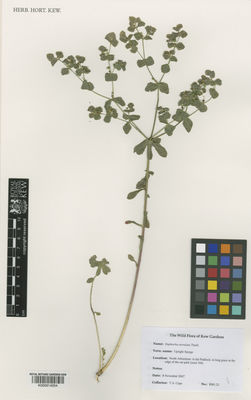-
General Description
-
The upright spurge is an annual herb, widespread throughout Europe but uncommon in the UK where it is found mainly in a small area around Gloucester.
Euphorbia stricta is an annual herb with a milky latex, widespread throughout Europe but uncommon in the UK except in a small area around Gloucester. Because of this it is sometimes known as Tintern spurge. It may also be found listed under the name Euphorbia serrulata. The plant is cultivated only occasionally, but spreads rapidly.
-
Species Profile
-
Geography and distribution
The upright spurge is found throughout southern Europe, reaching as far north as the southern parts of UK, The Netherlands and Poland and as far east as the Caucasus. It also has become naturalised in New Zealand.
Description
Overview: Euphorbia stricta is an annual herb growing to 1 m, always glabrous. Stems are often reddish with typically four to five axillary rays in the upper part.
Leaves: Leaves are oblong-lanceolate, finely toothed and subsessile.
Flowers: Flowers are in small groups consisting of a solitary female and several males surrounded by nectar-gland bearing involucral bracts which form a cup. The male flower consists of a single naked stamen on its own pedicel (so that it looks like a jointed filament). The female flower consists of a trilocular (3-valved) naked ovary, on a pedicel which usually elongates in fruit.
Fruits: The fruit is a 3-lobed dehiscent capsule, up to 2.5 mm in diameter and is covered in cylindrical warts or tubercles. The seeds are smooth and reddish-brown.
Uses
Can be grown as an ornamental herbaceous perennial or rock garden plant.
-
Ecology
-
Roadsides, beside streams and ditches, in moist grassy areas, amongst rocks in limestone and sandstone areas. From sea level to 1200 m.
-
Conservation
-
Independently assessed as of Least Concern (LC) according to IUCN criteria.
-
Hazards
-
Latex may severely irritate the skin causing acute dermatitis, and is poisonous if consumed. Contact with the eyes should be avoided. Seeds may have drastic purgative action.



